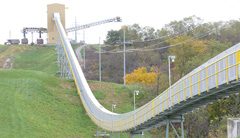By Richard Munson
Safety and sustainability are imperative considerations for large conveyor capital expenditures in industries such as aggregates, power plants and ports, but measuring these investments to ensure they make economic sense is not done as efficiently and as frequently as it should be.
For companies considering installation of an overland conveying system to reduce trucking costs, a fundamental economic evaluation is required to analyze the expenditure, but it’s not always easy to execute. There are several effective models for predicting trucking cost per ton. However, many project managers find the prospect of conducting a Net Present Value (NPV) or Cumulative Comparison of After-Tax Cash Flow analysis on an overland conveyor system overwhelming, and are unsure which variables are necessary to yield a professional and reliable result.
Conducting a simple After Tax Cumulative Cost Comparison of the difference between trucking and conveying costs will generate an annual difference in total cost of ownership that determines if the capital investment is worthwhile. And it is a much simpler process than many realize.
This type of analysis puts operating costs on the same footing as capital costs, including both is necessary for a true economic snapshot. Our method results in a graph that illustrates the breakeven point on the time graph, as well as the cumulative new cash flow difference between the two transport methods.
Here are the variables required for an accurate evaluation:
- Trucking cost per ton.
- Annual volume of material to be moved.
- Conveying operating cost per ton.
- Capital cost of the conveyor system.
- Tax depreciation schedule for the conveyor system.
- Corporate incremental income tax rate.
- Corporate hurdle rates.
Comparing the Costs
On average, conventional conveyor systems cost anywhere
from $400 per ft. to $1,000 per ft. for design and supply depending on topography and length and power requirements. Adding the installation and civil costs increases this cost per foot. These figures include design and supply costs, civil works, and mechanical and electrical installation. After the initial conveyor investment, the conveyor operating costs are significantly lower than trucking operating costs, which include labor, vehicle amortization, maintenance, repair, fuel, road maintenance and dust control. In many cases, there are additional hidden costs associated with trucking that are hard to identify.
A conservative cost per ton to operate a conventional conveyor system is $0.25 per ton. These figures assume costs for maintenance, operating labor, power cost and spare parts. A conservative cost per ton for trucking is $3.00 per ton. If the plant is moving 1,000,000 tpy of material, then the potential gross difference in cost is $2,750,000 which is a big number. Over five years this gross saving would amount to $13,750,000, which is potentially more than the cost of the conveyor. The costs keep inflating year after year and if the capital cost can be recouped in four years then the savings after that point are pure gravy.
Summary
In the end, the conveying versus trucking comparison is an evaluation between the total cost per ton of trucking over time versus the total cost per ton of a conveyor system, with the largest part of that per-ton operating cost being power. The operating cost per ton for conveying will always be much lower than trucking operating cost per ton, but the material volume moved over the project life will yield whether the conveyor investment is worthwhile.
The biggest variable in cost-per-ton for trucking is how many roundtrips trucks are making per hour. If the haul distance is short and direct, then the cost per ton will be much lower. If the distance is long and indirect, then the number of roundtrips per hour is reduced – sometimes to one roundtrip per hour – and the cost per ton is much higher. These are easy variables to calculate, with ancillary costs such as dust control and rain runoff control harder to get a handle on.
In many cases the numbers are similar, $3 per ton for trucking compared with $.10 to $.15 per ton for conveying.
Richard Munson joined BEUMER Corp. in 2010 and presently is director of sales, Capital Systems–Conveying & Loading in Kansas City.

